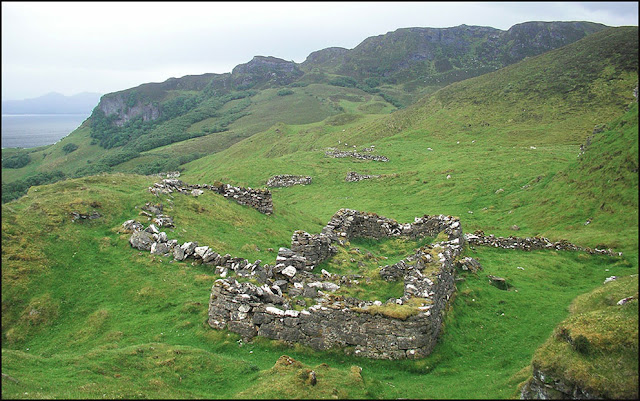It was back in 1998 that I first climbed Dun Cann, the summit of Raasay. Looking south from the summit, I saw the ruins of a large village set on a grassy ledge, 300 feet above the sea. A look at the map told me it was Hallaig, but I knew nothing of its history at the time. It would take a few years, but I would eventually learn about the Raasay Bard Sorley Maclean, and his best-known poem, Hallaig.
The village of forty houses was cleared of its people by George Rainy in 1854. Sorley MacLean’s poem evokes the author’s memories of this place where some of his family had lived; a place once full of life, but dead for a hundred years when the poem was published. But it is not truly dead. Hallaig invokes the truth that the spirits of the people remain in the landscape and wildlife: in the birch, the rowan, the hazel, and the red deer sprinting across the slopes of Cnoc an Rà.
Na h-igheanan nan coille bheithe / The girls a wood of birch trees
Direch an druim, crom an ceann / Standing tall with their heads bowedIn the following photo, taken from the summit of Dun Caan, the green plateau of Hallaig can be seen just left of centre.
Also to be seen from the top of Dun Caan were the ruins of Screapadal, three miles to the north—the subject of another poem by Sorley Maclean: Screapadal. There you will find the ruins of forty homes split between the townships of North and South Screapadal, separated by the peaty, cascading waters of An Leth-allt—another village cleared by Rainy.
Dh’fhag Rèanaidh Sgreapadal gun daoine, / Rainy left Screapadal without people,
gun taighean, gun chrodh ach caoraich, / with no houses or cattle, only sheep,
ach dh’fhàg e Sgreapadal bòidheach; / but he left Screapadal beautiful;
ra linn cha b’ urrainn dha a chaochladh. / in his time he could do nothing else.
Hallaig and Screapadal are places that must be seen, and there is no excuse not to, as both are easy, four-mile round trip hikes. That said, I cheated and got within less than a mile of Hallaig by boat. It was a couple of weeks ago, and the ship Hjalmar Bjorge had to shelter from a southerly gale. The bay below Hallaig, nestled by the hook-headland of Rudha na’ Leac, was the perfect spot.
Once ashore, a steep climb of 300 feet led to the Hallaig footpath, where we encountered the Hallaig Memorial Cairn, with brass plaques inscribed with the poem in Gaelic and English.
The path quickly dropped down through woodland to cross the Hallaig stream, then climbed to a sloping, 250,000 square-foot enclosure: Hallaig’s most visible feature from a distance.
’s tha mo ghaol aig Allt Hallaig / And my love is a birch forever
’na craoibh bheithe, ’s bha i riamh / By Hallaig Stream, at her tryst
Above the enclosure lay the ruins of eighty structures, some still standing; most just the low, grass-grown foundations of circular and rectangular dwellings. Most of the houses lay on a fairly level, grassy plateau, overlooked by the mantled summit of Dun Caan.
Before returning to the ship I made my way to the high, north end of the village. It was a magnificent spot and the location of the most intact of the many ruins. I realized it was a shame I'd not taken the time to hike here in the past, and next time I am on Raasay I will make the walk to Screapadale via Raasay Wood.
Tha iad fhathast ann a Hallaig / They are still in Hallaig
Clann Ghill-Eain ’s Clann MhicLeòid / All the MacLeans and MacLeods
na bh’ ann ri linn Mhic Ghille Chaluim: / Who were there in the time of Mac Gille Chaluim:
chunnacas na mairbh beò. / The dead have been seen alive.






















































